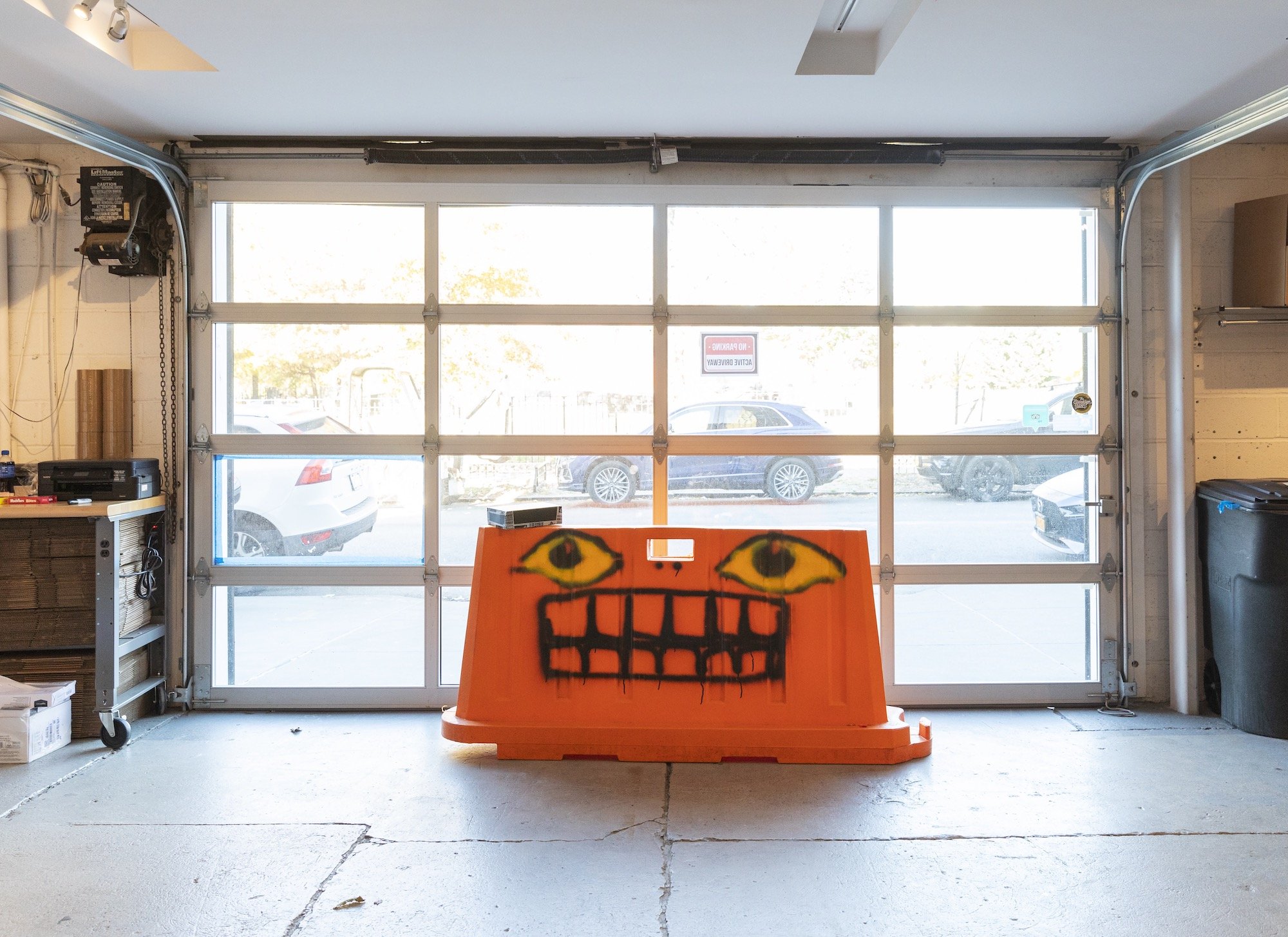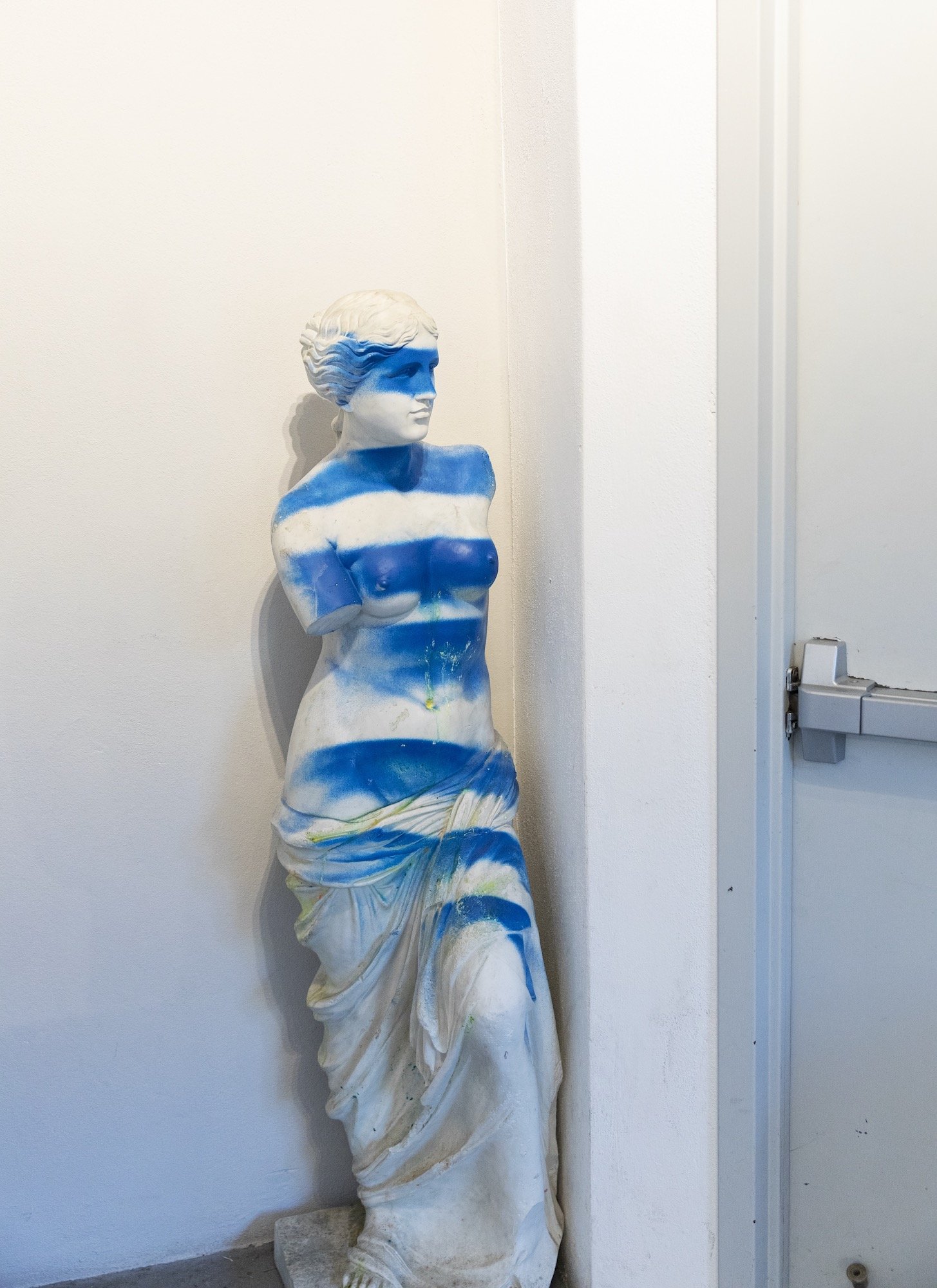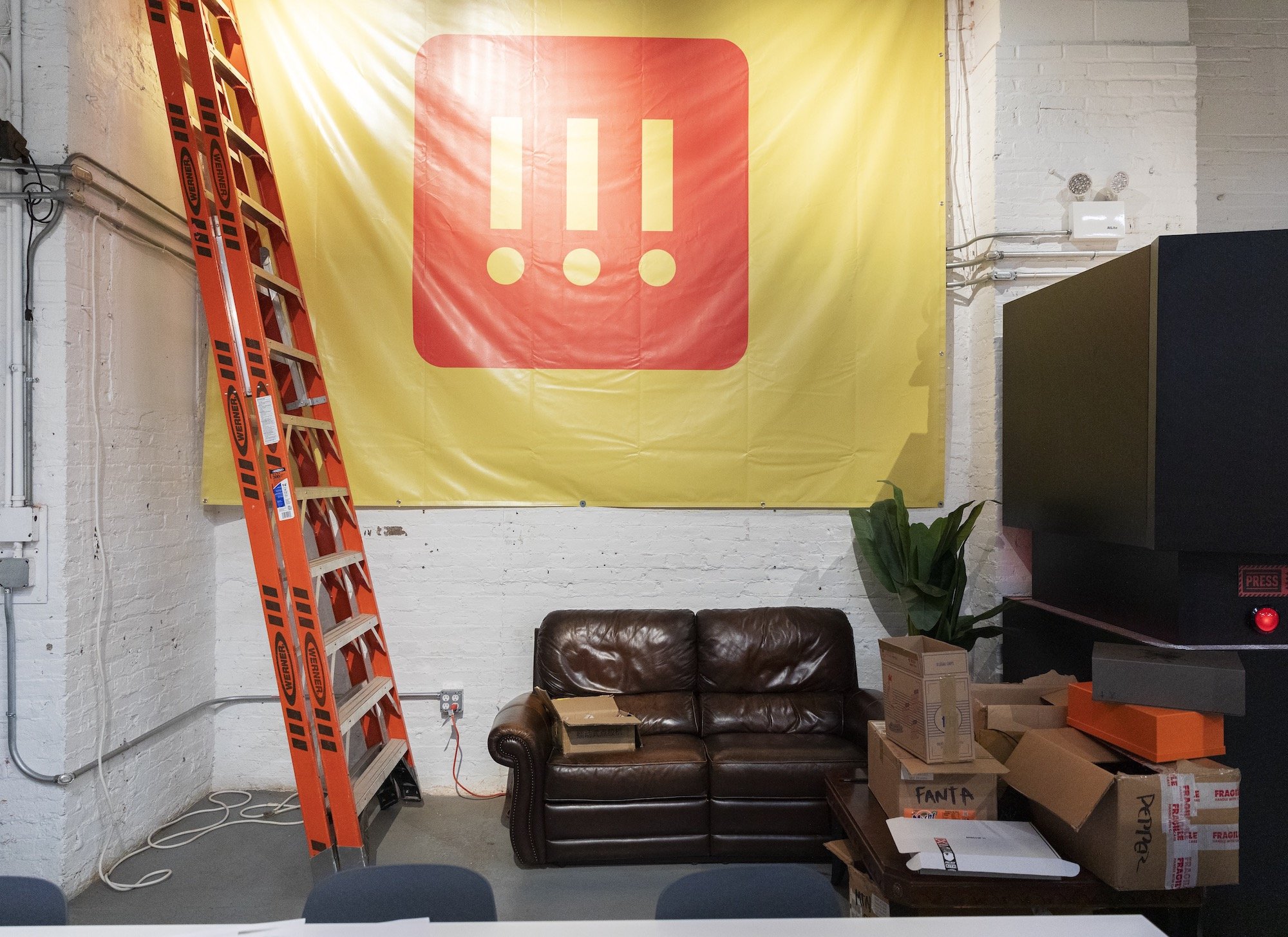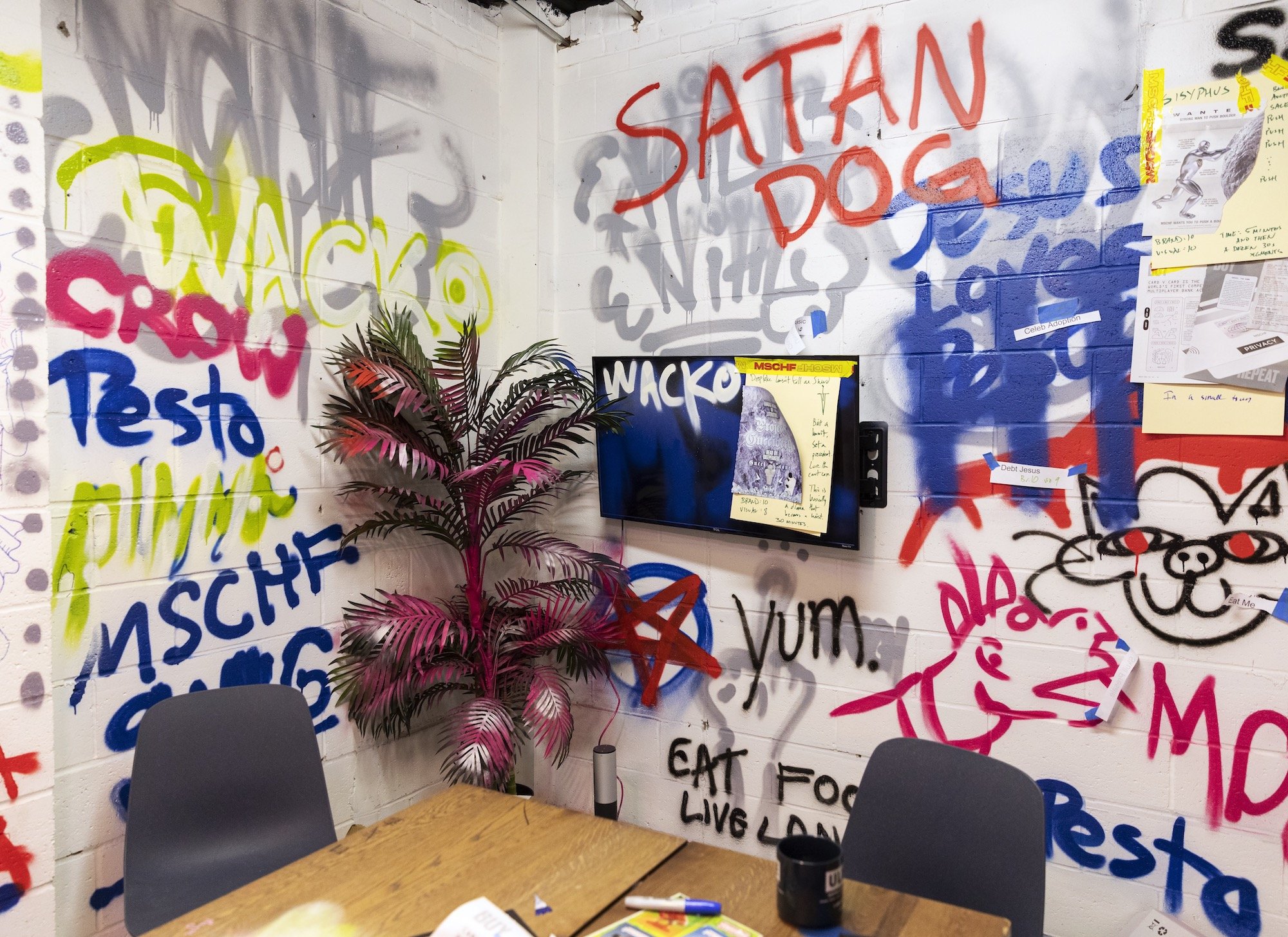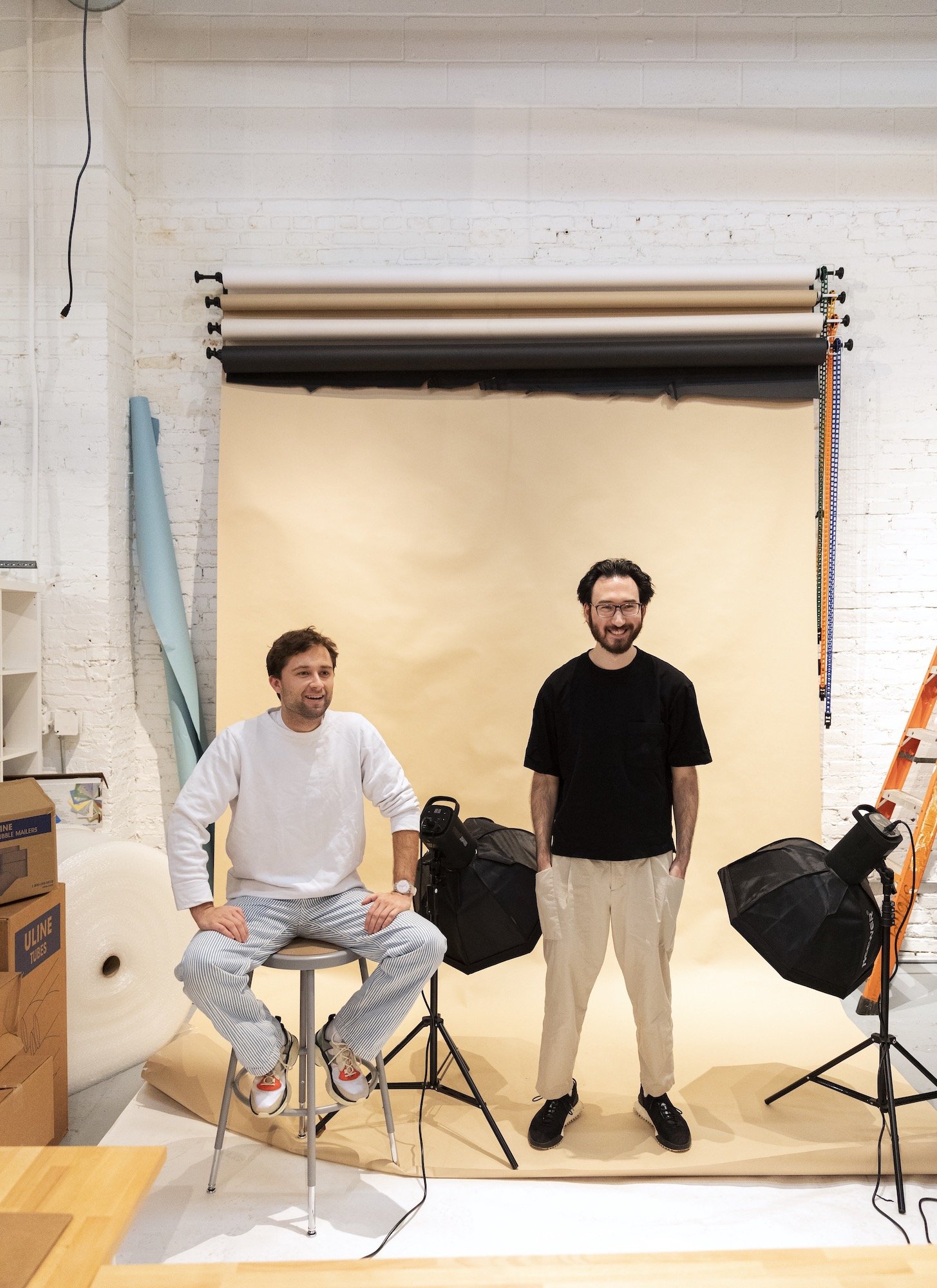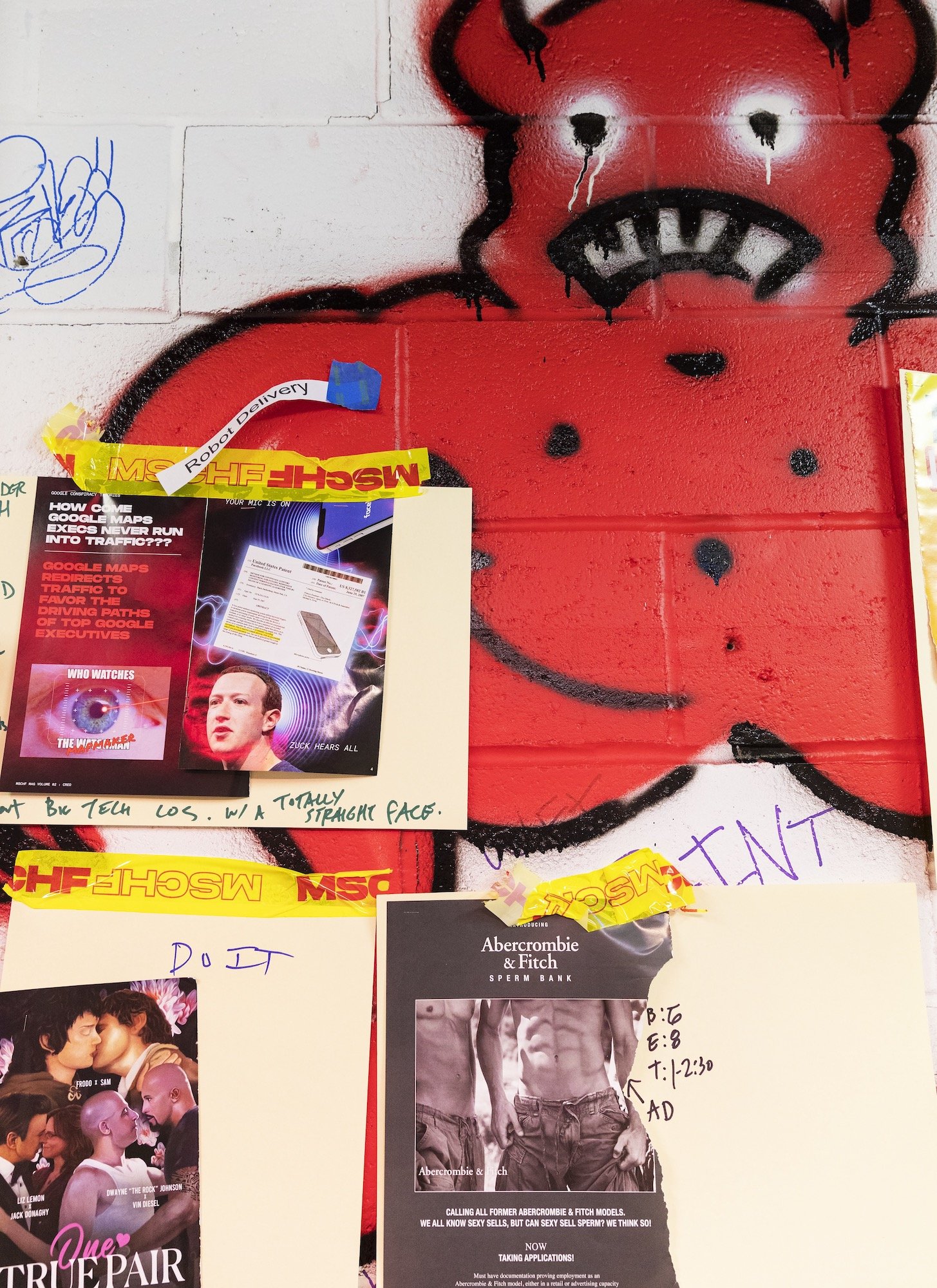The Spicy Present
The MSCHF studio in New York City (image: Dean Kaufman).
Exactly what is MSCHF? It’s a question that troubles the press and fans alike. The New York Times hesitantly described the creative studio in a 2020 headline as
a “Very Modern... Business?”. In media coverage, the studio’s name is prefaced with business-y words such as “company” and invariably described as a “start-up” that markets “viral pranks”. But these labels seem an awkward fit. Yes, MSCHF has publicly courted venture capital, is run out of an office in Brooklyn, and is staffed by young people in T-shirts, but it also has no logo, no one-note product, and seemingly no interest in making heaps of money.
On Reddit, where the studio’s fans congregate to compare notes on releases, the meaning of MSCHF is a topic of debate. When I poke my nose into the forum, people are arguing over Drop #56, Boosted Packs, which promise a random assortment of trading card-style ephemera. Tesla employee ID cards, Soho House membership chits, a Patrick Bateman business card. Some buyers are surprised to find only the meaningless detritus of capitalism inside their purchase. “STOP COMPLAINING,” posts username Bruhuha. “Don’t be mad that you opened up your packs and got junk from someones [sic] wallet, because literally they advertised that’s all they were. The whole point of MSCHF is to be a big joke on our cosumerist [sic] economy.”
Some of this confusion is intentional. Pronounced with all its missing vowels as mischief, the studio is Loki-like, a contemporary incarnation of the trickster god – a shape-shifter of a studio that delights in chaos. Each new project arrives fully formed, featuring an attendant website with a custom URL bearing a carefully curated graphic identity. MSCHF borrows from the streetwear corner of fashion with its distribution model, dropping limited quantities of new items once a fortnight. They always sell out in minutes. They promise to never do the same thing twice. In the time elapsed between writing this article and its publication, they will likely have reinvented MSCHF twice over.
A graffitied statue in the MSCHF studio (image: Dean Kaufman).
In the interests of editorial frankness, I’ve been a fangirl of the studio for a while. I get a kick out of its social experiment approach to design and find it refreshingly less po-faced than the design industry’s standard narrative of creatives earnestly setting out to save the world. I’m an anxious and depressed millennial that spends too much time online soaking in internet humour. I think MSCHF are punk, but for a time in which you have to interact with tech to get anything done. It grated on me that The New York Times would dismiss them as just a “business” marketing “viral pranks”, so I dropped MSCHF an email to ask them what they felt about the way the press talks about them – and how they’d describe the studio if pushed. “If we have to choose a single catch-all descriptor, we say that MSCHF drops are performance art using consumer culture, mass media, and celebrity as our artistic mediums,” co-chief creative officer Kevin Wiesner writes back. “To look at the things we put out into the world, which are narrative objects engineered to reach mass audiences and provoke conversation as a vehicle for our critiques and see them as something so straightforward as pranks is a terrible lack of critical thinking.” MSCHF online drops are Happenings for the digital age. Performance art that you can buy into or simply marinade in the discourse around. You are sucked onto the virtual stage by purchasing the product, or reading about it online, or reading about the reaction of the people who are pissed off by the art online. If you’re fast enough on the draw to snag a MSCHF design, you can own art too – but watch out or you may become a part of the piece.
From their earliest works, MSCHF drops have been full of black humour and internet silliness. Drop #11 was Toaster Bath Bomb, a macabre glittery dissolvable bathwater accessory that was also a carefully attuned send-up of corporations trying to monetise the small joys required to survive under capitalism. But the drops are a little bit serious too, accompanied by a manifesto that lays out exactly what systems-level wretchedness MSCHF means to skewer. Toaster Bath Bomb is accompanied by a ‘Memetic Analysis’, which traces its origins from the self care industrial complex (“Lush Bathbombs. If all you can sooth is your meat shell, then soothe it to excess”) to doomer memes (“The ‘Noo Don’t Kill Yourself You’re So Sexy Aha’ Snapchat meme presupposes both that it is not unusual for a casual Snapchat to discuss the possibility, and also flattens the dialogue into the same unremarkable horny-braindead patterns of late night flirtation”). Suicidal ideation as a running joke and brands that capitalise on the endorphin rush of small, ephemeral products marketed as a balm for persistent low mood: these are heavy topics. But MSCHF wears them lightly, smuggling in its bitter subtext under a tasty layer of digital culture. But don’t mistake the bleak subject matter for nihilism. “To critique how much the world sucks necessitates an acknowledgement that it could be better,” Wiesner tells me over email.
(Image: Dean Kaufman).
Critiquing consumer culture and capitalism is hardly a novel position for a contemporary critical design studio to adopt. But MSCHF punches through the conceptual-only approach by inviting everyone to pay-to-play and consume along at home. Simply text their number to get the link to download their app (natch) and, once a fortnight, you can try to buy whatever it is they’ve cooked up next. The studio uses its drop/manifesto model to hoist feel-good marketing, luxury fashion and the art market by their own petards. But just because it embraces digital distribution models and top-of-the-line graphics, the studio doesn’t spare the design world or the tech industry from satire and skewering. Enter drop #50, Dead Startups Toys, an adorable range of five miniature models that memorialised tech’s most egregious fuckups. The toys are Funko Pops for people with a Tech Won’t Save Us tote bag. Winged cherubs dancing on the product’s landing page are superimposed with the face of Elizabeth Holmes, who is now on trial for her part in Theranos, a scam blood-testing business. A miniature Juicero – the $400 WiFi-connected juice press that turned out just to squeeze out bags of pre-pressed pulp – is as much use as a real one, and a whole lot cheaper. A good “big joke on cosumerist [sic] culture” always punches up.
Overblown startup valuations bloated with venture capital, overnight crypto millionaires, every hobby a side hustle – sometimes it feels like everyone wants to get rich or buy trying. But Loki was the god of fire as well as mayhem, that promethean source of heat and light that can trigger alchemical reactions – or turn everything to ashes. MSCHF refuses to revere financially sacred objects, often destroying items deemed valuable by cultural association to create new works. Last year, the studio acquired a Damien Hirst Spot painting (L-Isoleucine T-Butyl Ester, 2018) for $30,485. Enacting its own Judgement of Solomon, the studio cut it up into individual coloured dots so that 88 people could own a piece of one piece of art. Sold as drop #20, Severed Spots lampooned the art world’s pipeline of manufacturing goods that go straight into bank vaults. “Maybe we don’t need more zombie wallworks,” reads its manifesto, “we just need to distribute the ones we’ve got.” Earlier this year, Birkinstocks (drop #39) similarly saw the studio slice up $45,000 crocodile-skin Birkin bags, arm candy of choice for the super rich and famous, and turn them into pairs of Birkenstocks, the sturdy and affordable cork-soled norm core sandals beloved of hippies and lesbians (I’m a queer that makes my own granola and I own two pairs). “ADDITIONAL STEPS INCREASE RETAIL VALUE,” shouts the accompanying screed. “THEREFORE: MAKE LUXURY OBJECTS OUT OF OTHER COMPLETE OBJECTS.” MSCHF had to acquire its sacrificial leather goods on a resale site, as Hermès employs a scarcity model to push up the value of its Birkin bag.
MSCHF are well versed in the dark arts of going viral, so its collaboration early this year with Gen Z icon, musician and king internet troll Lil Nas X was a match made in heaven that raised hell. In the music video for ‘Montero (Call Me By Your Name)’ Lil Nas X sings about gay sex as he snogs a penis- snake, is stoned to death by butt plugs, then pole dances down to Hell in thigh-high patent boots to twerk on Satan before snapping his demonic neck. It’s a masterpiece filled with religious iconography that rewards careful rewatches, and the eagle-eyed viewer can spot that the Devil himself is wearing custom black Nikes. Enter MSCHF, which created 666 pairs of trainers customised with a drop of blood contained within their air cushions and a silver pentagram charm. An Evangelical Christian pastor denounced the shoes as “devil-worshipping wicked nonsense”. Nike sued and MSCHF settled. Perhaps MSCHF’s approach to performance art as products is best summed up in its statement on the legal trouble, published 1 April: “There is no better way to start a conversation about consumer culture than by participating in consumer culture.”
(Image: Dean Kaufman).
Wiesner and MSCHF’s other CCO, Lukas Bentel, met in art school and used to run an artists’ group together called Hello Velocity before joining MSCHF CEO Gabriel Whaley. Bentel cites performance art influences such as The KLF – a 90s British electronic band that set fire to £1m on a Scottish island in a performance art action called K Foundation Burn A Million Quid – and Maurizio Cattelan, he of duct-taping-bananas-to-a-wall fame. Wiesner is also an admirer of Dunne & Raby, the progenitors of contemporary critical design and course leaders of the Royal College of Art’s influential Design Interactions MA between 2005 and 2015.
After our initial email conversation, I arrange a call with MSCHF’s two CCOs on Zoom. I’m eager to spy on their chosen backdrop for the call. Early press coverage of MSCHF delighted in the studio’s office, which proved catnip for millennial workers with its graffitied bathrooms and a meeting space dominated by a giant white pentagram marked up in white over a floor painted black, as if their ideas were being summoned from a Hellmouth. I was hoping we could get some shots of it, enormously tickled by the element of foreshadowing given that MSCHF had played a crucial part in manifesting a very real satanic panic mere months before. But now, with fans desperate to preempt their every move, they’ve taken to guarding their secrets more carefully, concerned with preserving the crucial element of surprise of every new drop. Photographs inside are verboten. As they apologise politely, they describe the MSCHF studio as having a “black box policy”. At first I think it’s a malaphor for a black site – where governments and militaries secretly conduct nefarious deeds – but then Google informs me it’s a tech phrase: a term in computing and engineering where an output can be received without any knowledge of its internal workings. MSCHF works in mysterious ways; the mystique must be maintained.
Scanning for clues during our video chat, I subtly try to decipher the scribbles on the whiteboard behind them, decode the meaning of obscure glyphs. One looks like a little bowl or a seashell, another like a Christmas cracker or maybe a miniature bear trap. I give up on trying to guess at the future. The conversation is too engaging for my eyes or brain to drift, anyway. It’s the most energetic video conversation I’ve been on in a while. There is office hubbub outside the door and Slack, the office chat software, is running in the background, pranging out my attention economy-addled brain with its distinctive staccato clack-chirp. It’s early afternoon in New York City to my dark English evening, and Wiesner and Bentel bounce off each other with an easy familiarity that almost borders on a hivemind, finishing one another’s sentences and queuing up questions for each other, making my job as an interviewer almost ancillary.
Lukas Bentel (left) and Kevin Weisner (image: Dean Kaufman).
India Block How did MSCHF come to be? What’s your origin story?
Kevin Wiesner MSCHF started in 2019. Lukas and I worked together ourselves before then, and the rest of the team were working by themselves as a group before then as well. But we came together as what MSCHF actually is in 2019. It came out of a few basic original tenets that we wanted to pursue, the first of which was very simple. We wanted a structure wherein we could make only the things we wanted to make. We wanted to see if we could build an audience around totally disparate things. Each drop would have nothing to do with each other. And the core framework that we set from ourselves at the get-go was, we’re gonna drop something once every two weeks, come hell or high water. And that’s gonna be our true, concrete starting point. Because other than that–
Lukas Bentel We had nothing.
Kevin There might not be any obvious connection between projects. And it’s spiralled out of control from there. The original team was five or six, and we’re now up to 23. And when we look back at the past two years, we’ve actually averaged an output every 10 days for the past two years. So we’re beating our own schedule fairly substantially. Still just chasing that high. We want bigger and bigger stuff each time.
“Golf Sucks” trophy from a referrals reward scheme (image: Dean Kaufman).
India A launch every 10 days is an insane schedule. How do you guys manage that? And is that 10 days start to finish?
Lukas No, no, no, everything is planned out.
Kevin People think that from the outside. But that is absolutely not the case.
Lukas It would be impossible to do everything that we do with that timeline. We’re almost a year planned out in terms of our drop schedule.
Kevin We have stuff planned through to August of next year. A lot of the things that come out have been in the works, in terms of design, anywhere from six to nine months. But that is kind of the magic of it when new work comes out back-to-back. “Oh, how did they do that in the timespan?” It’s this magic thing called working on more than one project at once.
India Do you have any particular favourites from the projects that you’ve done in the past year?
Lukas Personally, Separate Spots was a great project. Because, in one sense, that was one of our first art-specific projects. Kevin and I are coming more from that background. That was a project where we bought a Damien Hirst painting, chopped it up, and sold all the dots. It was one of these moments where we realised we did something where everyone else would have been really scared to touch an object like that and chop it up, because it seemed like a complete waste of money – and a terrible risk. But it solidified our “nothing is sacred” mentality.
A sword made from a melted gun as part of the buyback programme, Guns 2 Swords (drop #54) (image: Dean Kaufman).
Kevin I think Guns 2 Swords, in a lot of ways for us internally, represents a logistics high watermark. It was an idea that we had two years ago, practically right when the company started. The prospect of actually setting up a gun buyback programme, unaffiliated with a city or a police department or anything, was pretty daunting. It was in the works for a very long time. It feels to me like a real, tangible sign of our growth in terms of what we’re able to execute. And obviously, I love the fact that we’re making swords and have Grimes carrying them around.
India Did she give you a gun to melt down? And how did you land on its pulp fantasy book cover aesthetic – was it to appeal to the incel demographic?
Kevin It was not to appeal to the “incel demo” but because the aesthetic of pulp fantasy covers absolutely slaps. That said, it probably does help us appeal to the compensatory big dick energy of assault weapon owners, and in that sense serves the drop extremely well. Grimes did not give us a gun, alas. We lent her one of our prototype units for the Met Gala.
India But is it your favourite drop?
Kevin I hate this question, because as Lukas knows, I’m always obliged to give my honest answer about what my favourite drop is, which is the AI generated foot-pic bot. To me, it’s an excellent example of a general principle with MSCHF drops. We want them to have an immediate hit in one sentence, which is “AI foot-pic bot”, and also to hit harder in three sentences. That’s the rubric we use. If you dig into that drop, it is a vehicle for looking at the insane economic dynamics of feet pics, between being super valuable to some people and totally worthless to others. The people who are consuming them tend to be the people who think they’re super valuable, and the people producing them tend to think that they’re throwaway memes, which is a bizarre supply-demand dynamic. They’re also the perfect content to ghost through any censorship law that you’ve cared to devise for internet platforms, because it’s like, “What is this?” To some people it is literal porn. And to some people, it’s like,“lmao [he pronounces the acronym “la mao”, rhymes with “ow”, ed.] that’s a pic of a foot”. Which is great. Feet pics sit at the focal point of so many core internet content dynamics, I think they’re really interesting. But I always sort of resent that this question turns me into the foot pic guy every time.
(Image: Dean Kaufman).
Lukas I think the most interesting thing about that project is that you can text it for foot pics, but it is tackling all these questions. If you go to the site, there’s a pretty lengthy description of those interesting economic thoughts around foot pics, and the social dynamics and the technology. You could write an article about that same subject matter, and maybe in a certain publication you can get 10,000 people looking at it. This foot bot with this text has literally been texted multiple millions of times. It’s a reach thing. With a lot of the projects we try to take some concept, take some thought, and start a conversation and move it as far into culture as possible. As opposed to just talking about it over here, then maybe not engaging with the actual phenomena or group that you’re actually talking about or critiquing, we made something to push into that space.
Kevin It’s an extremely good Trojan Horse vehicle for the conversation that we want to have. But also hyper-tailored to the audience that’s engaging with, in this case, feet.
India Did Damien Hirst ever respond to you cutting up his artwork?
Lukas He never did. The Spot paintings are him just printing money. He probably doesn’t even give a shit about them. He already made his money from that piece.
Kevin Right. We did have a group of folks come through the office one day, and two of them turned out to be friends of his. They were just along for the ride to see who was cutting up the painting, which was amusing.
India But with Spot’s Rampage, that definitely provoked a response from Boston Dynamics.
Lukas We got a Boston Dynamics robot, we put a paintball gun on it, we put it in a space, and let people control it from their own home with their phones. The craziness happened even before the project launched. We set up the project and talked to some press about it beforehand, and some of them ended up contacting Boston Dynamics, who really freaked out. They made this whole public statement saying that, while they believe in freedom of expression, etc etc, they think that this is bad positioning.
Kevin Wiesner (image: Dean Kaufman).
Kevin I think they said “We condemn any use of our robots in a context that’s associated with violence”. That was their wording, approximately.
Lukas And of course that was the Barbra Streisand effect [when trying to suppress information backfires and elicits furious internet speculation where it may only have been lukewarm prior, ed.] and it becomes so much bigger than it actually was. In some sense they made the story, because they were engaging with it.
Kevin They offered us two free robots if we would take the gun off the thing.
Lukas We said no, even though that would have been very nice financially, but we launched the project anyway. They got some bad press for it, but to be honest the robot doesn’t even work.
Kevin The thing is, they shoot their own sizzle reels. But when you actually get this thing, it can walk forward and backwards, turn left and right, and it can move at a top speed of three miles an hour.
Lukas It’s really slow.
Kevin It’s still scary when it points the gun at you – there’s something really off-putting about that experience. But they have to constantly hype up their own robot, which really made the project. The other thing that they did, which was so ludicrous – we didn’t plan this, it just happened to be the day after the drop – was that the Spot robot got rolled out in the Bronx in a partnership with the New York Police Department. We’re sitting over here, reading the statement that says you can’t use the robot near a gun or in a context associated with violence, and there’s an armed patrol 30 minutes north of us right now which has the robot? Ridiculous. You always hope for reactions that add to the concept and boy, they sure did. We connected the robot to WiFi several months later and it started an automatic software update, and we found out that they changed our operating licence to expire in 1969. So the robot is just bricked.
Lukas They shut our robot off.
Card v Card (drop #29), a multiplayer game where contestants received debit cards tied to one bank account and then raced to make IRL transactions (image: Dean Kaufman).
India Probably my favourite thing that you’ve done was Dead Startup Toys.
Kevin That was a fun one and it’s interesting from an audience perspective as well, because we took internal bets on which of the failed startups people were going to most recognise the most. We were completely wrong.
Lukas In terms of which ones sold out quicker.
Kevin Dead Startup toys is that collection of companies that represents a snapshot in time to me. Okay, wow, this was what Silicon Valley was doing for about a year-long period.
Lukas They were trying to save the world. They did all this–
Kevin Garbage. But, the thought process that led to something like the Juicero is a kindred spirit to how MSCHF thinks, except without any sort of satirical remove. When we talk about the intensification of the present, all of those Dead Startups represent that very well. That’s part of why we like them. It’s so funny that when we’re doing the background research, you find out how many of those are funded by the same people, even designed by the same people. I think Yves Béhar is represented in at least three of them [Béhar designed the Juicero and the XO Laptop, and helped with the casing for Theranos’s Edison machine, ed.].
Lukas It’s hilarious.
Kevin The legacy that they leave is not good, but it is coherent across them.
Lukas Bentel (image: Dean Kaufman).
India Do you have an audience in mind when you’re making things? Do you know who is signing up to the drops, who’s texting for the feet pics?
Lukas The fan base does not affect what we make. We have no idea–
Kevin We have so little data about who the fan base is. Drops do accumulate totally different audiences from each other. Each time a drop comes out, there will be some group of people who think, “Oh, this was made just for me, I am MSCHF’s core demographic”. We did this project Mickey 2024 recently, which was all about poking and prodding the bear that is US copyright law and Disney. And Law Twitter loved this, they got such a kick out of it. Over time, this adds up to a totally wacky collection of people, from five-year-old kids to 65-year-old art collectors. We got to see it in person for the first time just recently. We did a pop-up called 8-Twelve, which was a fully rebranded, really spooky, bootleg 7-Eleven. It was a physical installation in the Lower East Side and it was fantastic. It was up for two days and we had 100 people lined around the block both days. Looking at who was standing in that line was hilarious, you have everyone from the dripped-out kids to the suited-up ad execs who were following us out of academic interest. You have the cool art kids – maybe that was just because it was in the Lower East Side. It’s such a bizarre mash-up of folks, because everyone finds their own entry point from the drop that they like most, which is nothing like what somebody else came in with. The kids who came in from Satan Shoes are nothing like the people who came in from the Foot Bot, for example. I mean, I think that’s awesome. At the end of the day, it is not like we have a core demographic that we’re trying to cater to. It’s not top down, like, “All right, we need to go after people ages 25 to 34 with disposable income”. It’s very much emerging from the things that we’re putting out, which is a lot nicer as a way to work, I would say.
Lukas We want to make the interesting things that we want to make. We don’t want to be looking at the people looking at us, trying to figure out what they want. That just feels like a bad way to work.
(Image: Dean Kaufman).
India The graphic identities for each drop are so different, which I think helps make them distinct when people come across MSCHF for the first time. How do you go about planning that?
Lukas That is very specific to one part of MSCHF, where we say that MSCHF can fit anywhere seamlessly. We want to feel – when we’re making something and trying to go into that space – that it exists and that we could fit in as seamlessly as possible. To that end, we have no specific MSCHF branding, because that would be counterintuitive. Every single drop is completely rebranded. It’s its own experience. It’s tackling a different audience, it’s going in a different space. Every drop ends up looking completely different, as part of the way we think about these projects.
Kevin We consciously said at the beginning, let’s see what happens if we just don’t have a logo. We’ll just try to build an identity out of a point of view and a sense of humour. Because we’re trying to choose aesthetics and cultural elements to Trojan Horse our way into different parts of culture, it is very helpful to not have anything fixed. All the aesthetics are just tools to help the concepts.
Lukas They are the pieces of the palette that we can use.
India Using humour as a medium must be hard, because it’s difficult to get right. Especially internet humour, which moves quite fast. How do you keep ahead of that?
Lukas We were talking about this the other day. We are not reactionary. Obviously, our projects are reacting to the world. But we’re not reactionary to the extent that I think a lot of other people are where they’re on social media and they’re responding to the latest and greatest things because of the timelines. We are purposefully completely off platforms. We’re not really on Instagram, we’re not really on Twitter. We have our handles there, but we don’t want to use them as channels.
Kevin It just flattens everything.
Lukas It puts everything in a box that we don’t want to exist in. Our timelines for reacting to things are much longer.
A copy of MSCHF Mag Volume 5: BAM (drop #58) (image: Dean Kaufman).
Kevin They are abstracted one level higher from individual instances. Boston Dynamics is a decent example, because they’re something that’s been in and out of people’s attention over the span of a few years. But that as a trend is different from the specific day that they rolled out in the Bronx. With regard to humour, a lot of what we’re doing is just taking the present and making it more so. It’s a little accelerationist, it’s a little absurdist and solutionist. A lot of what we do is to look at what exists and then extrapolate it to its logical endpoint. And that turns out to be often hilarious.
Lukas We often say the spicy present.
Kevin It’s not about the future, it’s about the spicy present.
Lukas There are a lot of people that are like, “Let’s think about what’s going to change in the future,” but there is already a bunch of really crazy shit that’s going on right now. Let’s just take it, digest it and spit it back out, but slightly heightened.
Kevin Especially when it comes to celebrity and disruption.
Lukas The material that we’re playing with is something that I don’t really know whether any other groups are playing with it in the same way.
Kevin When you say “material”?
Lukas Like when we see a celebrity, or a Nike shoe, or a Birkin bag, we look at this as material that we can play with. These are all objects and symbols that exist. When you walk outside, you see Nike shoes. Maybe if you look online, and you see some really wealthy people, you’ll see Birkin bags. The materials that we’re playing with are materials that everybody engages with day to day. We try to actively use those objects in the works, and we’re not just making jokes about those objects. We’re not writing about those things, we are actively taking those things and smashing them together into interesting narrative objects.
Kevin That process in terms of readymades, but using cultural phenomena.
Lukas Cultural readymades.
“Impossible” patchwork T-shirt, one of 1,000 garments made from cut-up clothes from 10 streetwear brands (drop #25) (image: Dean Kaufman).
India Do you have budget constraints to work with?
Kevin The thing that we don’t have, which is very freeing, is an obligation that drops necessarily have to make money. Some of them do, and some of them don’t. That’s an incredible degree of freedom. Also, when you put out stuff that very obviously has no profit motive, it just makes people’s brains explode.
Lukas It’s funny, in the art world, if you see an artist and their whole practice is doing performance art you’re like, “Oh, okay, that’s cool. I understand that.” But then if you do something that engages with people in a commercial or pop culture space that doesn’t obviously make money, people are like “Wait”. There’s that split.
Kevin No one looks at Marina Abramović sitting down for The Artist is Present for 12 hours–
Lukas Saying, “That doesn’t make any money”.
Kevin “She’s not getting paid, she’s just sitting in a chair.” But that doesn’t bother anybody.
A fridge decorated with a “voice activated” sticker given away in copies of MSCHF Mag (image: Dean Kaufman).
India Do you have any themes or particular subjects that you’re interested in exploring next?
Lukas There’ll be some more art world stuff.
Kevin We will not tell you anything specific, I’m afraid. But we have themes that we run with, some of which are fine art, some of which are subverting or using the idea of celebrity and celebrity culture for our own ends. We have a couple of fun ones in that vein. We’re doing some consumable products for the first time, which is a big one for us. We haven’t done that before.
Lukas There may be some more foot-related stuff.
Kevin Can’t rule it out.
Words India Block
Photographs Dean Kaufman
This article was originally published in Disegno #31. To buy the issue, or subscribe to the journal, please visit the online shop.

